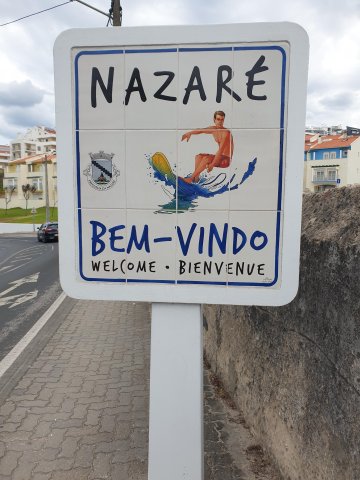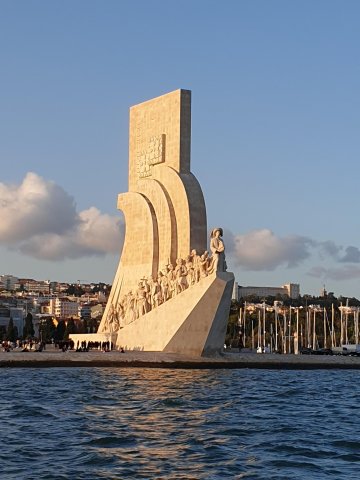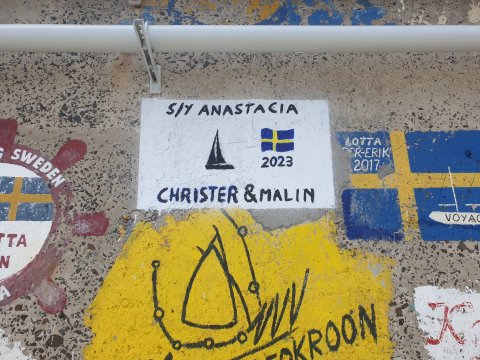
To avoid killer whales along the coast of Portugal, the recommendation for sailors is to stay within 20 m of depth. The only problem is that in these shallow coastal waters there are many fishing buoys and fishing nets which must be avoided and which are not visible at night. We left Vigo with the intention of stopping and anchoring halfway before reaching Porto as it was over 60 nautical miles distance. That would mean two comfortable 6-hours of sailing for us, with no night-sailing. We both fully agreed on the excellent plan as we set off late in the morning and looked forward to two sunny, beautiful days of sailing towards Porto. We also had a brilliant start with sunny weather and a good tailwind. So good that, at every possible anchorage we passed, we said to each other: Well. Let’s continue a little further... The result was that we eventually approached Porto in pitch darkness and I (Malin) had to stand at the bow with a flashlight and shout to Christer, who was at the helm, the direction of net buoys and other floating fishing gear that appeared in front of Anastacia so we wouldn't sail on them. The dew had fallen so we were also quite wet as we eventually approached a sheltered beach off the mouth of the Douro River that flows through Porto. Tired, wet, hungry and grumpy, we finally dropped anchor at half past two in the morning. It is said that planning when sailing is important! Following the plan obviously remains to be learned😊
It is difficult to get all the way into Porto by sailboat, so Douro Marina made a good base for the almost two-week stay. In the area there are several smaller restaurants, a bakery, a small grocery shop, a farmers’ market and, not least, an ancient laundry where you can still wash your laundry by hand in smaller basins and hang it on drying racks outside. In short, everything you need to be able to live a good life 😊 At the marina, they have made a point of working as much as possible for the environment and saving natural resources. At the reception, receipts etc. are printed on the back of old documents. To save paper, we were told. The forest and the many different types of trees are apparently an important natural resource for Portugal that they want to use wisely. Not least the cork trees, from which all kinds of sustainable products are made - not just wine corks! At the marina there was also a so-called Seabin, a marine dustbin, which collects plastic and other rubbish from the surface of the water which can then be taken care of. Also, here, as in most places we visited in Spain and Portugal, the opportunity to leave sorted waste has also been good and there have been an unusually large number of places with waste sorting bins in the cities. It's hard to find good excuses to throw your waste somewhere else! Litter on the streets, beaches and in the water is removed at regular intervals. In the ports, we have also seen cleaning workers of a slightly different kind who seem to thrive and eat off the remains that end up in the water and where many often wash off their boats. After a bit of asking and Googling, we came to the conclusion that it must be the Flathead grey mullet (Mugil cephalus) which thrives in most waters and feeds mostly on plankton and algae.
After a few days, we were visited by our sons Filip and Isac and childhood friend Joel. Anastacia was now transformed into a mini-hostel with three extra beds for our guests. A nice and lively company that contributed to many laughs! We managed to do most of the things in Porto that were on the boys' "bucket-list": We crowded together with all the other tourists at the Luis I bridge and the old districts, the cathedral Sé do Porto and several other old churches. We saw many exciting houses covered with tiles in different patterns and walked in narrow alleys. However, we only saw the Livraria Lello bookstore, that JK Rowling is said to have been inspired by when she wrote the Harry Potter books, from the outside. The several-hour-long line to the entrance was discouraging. Wine tasting of different vintages of port became one of the highlights as well as restaurant visits with local dishes such as Porto's pride, Francesinha. A toast with various layers of toppings, lots of melted cheese generously covered in a tomato sauce containing beer (!) and sometimes topped with a fried egg. It tastes interesting, we thought 😊. In the mornings we went to a small bakery and bought breakfast bread and pastries. Among other things, the national pastry Pastel de nata and the tasty, fluffy and golden-yellow Croissant Brioche, which gets its color from egg yolks. We also had time to swim on the long beach with the big Atlantic waves rolling in and a day's sailing south with three brave gentlemen who tried in different ways to ward off seasickness.
Porto (and Portugal) has been hit hard by the pandemic. After several lockdowns, there is much that has not yet recovered. Among other things, there used to be ferries across the river, between the city districts. These have not yet started. It is also noticeable that the societal gaps are large. Prices for food, petrol etc. are a little lower than in Sweden but, as an employee at the marina put it: With a minimum wage of around 750 EUR/month before tax, everything is very expensive. He himself could not afford a car, despite full-time employment. We saw more affluent areas with beautiful houses and gardens but also many areas that were dilapidated. At the same time, new buildings are being built everywhere and the apartment prices in Porto seem to correspond to the prices we have in our Swedish big cities. It is easy to understand that many people are having a tough time!
~~~~~~
För att undvika späckhuggare längs Portugals kust är rekommendationen för seglare att hålla sig inom 20 m djup. Problemet är bara att vid dessa grunda kustvatten ligger många fiskebojar och -nät som måste undvikas och som inte syns nattetid. Vi lämnade Vigo med föresatsen att stanna och ankra efter halva sträckan innan vi nådde Porto då det var över 60 sjömil dit. Det skulle innebära två behagliga 6-timmars dagsetapper för oss, utan nattsegling. Vi var båda helt överens om den förträffliga planen när vi startade en sen förmiddag och såg fram emot två soliga, sköna seglingsdagar mot Porto. Vi fick också en strålande start med soligt väder och god medvind. Så god att vi, vid varje möjlig ankringsplats som vi passerade, sa till varandra: Äh. Vi fortsätter en bit till… Resultatet blev att vi så småningom närmade oss Porto i beckmörker och Jag (Malin) fick stå vid fören och lysa med ficklampa och ropa till Christer, som stod vid rodret, riktningen till nätbojar och andra flytande fiskeredskap som dök upp framför Anastacia så att vi inte skulle segla på dem. Daggen hade lagt sig så vi var dessutom tämligen blöta när vi så småningom närmade oss en skyddad strand utanför mynningen till floden Douro som flyter igenom Porto. Trötta, blöta, hungriga och surmulna lade vi tillslut ankar vid halv tvåtiden på natten. Det sägs att planering vid segling är viktigt! Att följa planen återstår uppenbarligen att lära sig😊
Det är svårt att ta sig ända in i Porto med segelbåt så Douro Marina blev en bra bas för den, nästan två veckor långa vistelsen. I området finns flera mindre restauranger, bageri, liten speceriaffär, grönsaksmarknad och, inte minst ett anrikt gammalt tvätteri där man fortfarande kan tvätta sin tvätt för hand i mindre bassänger och hänga på torkställningar utanför. Kort sagt, allt man behöver för att kunna leva ett gott liv 😊 På marinan har man gjort sig vinn om att arbeta så mycket som möjligt för miljön och spara på naturresurserna. I receptionen skrivs kvitton m m ut på baksidan av gamla handlingar. För att spara papper, fick vi veta. Skogen och de många olika trädsorterna är tydligen en viktig naturresurs för Portugal som man vill använda klokt. Inte minst korkträden som man tillverkar allehanda hållbara produkter av - inte bara vinkorkar! På marinan fanns också en s k Seabin, en marin soptunna, som samlar plast och annat skräp från vattenytan som sedan kan tas omhand. På marinan liksom på de flesta ställen vi besökt i Spanien och Portugal har också möjligheten att lämna sorterat avfall varit goda och det har funnits ovanligt många platser med sopsorteringskärl i städerna. Det är svårt att hitta bra ursäkter för att slänga sitt avfall någon annanstans! Skräp på gator, stränder och i vattnet plockas bort med jämna mellanrum. I hamnarna har vi också sett renhållningsarbetare av ett lite annat slag som verkar frodas och äta av de rester som hamnar i vattnet och där många ofta sköljer av sina båtar. Efter lite frågande och Googlande kom vi fram till att det måste vara Storhuvad multe/Flathead grey mullet (Mugil cephalus) som trivs i de flesta vatten och livnär sig mest på plankton och alger.
Efter några dagar fick vi besök av sönerna Filip och Isac samt barndomsvännen Joel. Anastacia förvandlades nu till ett mini-hostell med tre extra bäddar för våra gäster. Ett trevligt och livligt sällskap som bidrog till många skratt! Vi hann med det mesta i Porto som stod på killarnas ”bucket-list”: Vi trängdes tillsammans med alla andra turister vid Luis I-bron och de gamla stadsdelarna, katedralen Sé do Porto och flera andra gamla kyrkor. Vi såg många spännande hus klädda med kakel i olika mönster och gick i trånga gränder. Bokhandeln Livraria Lello som JK Rowlings sägs ha inspirerats av när hon skrev Harry Potterböckerna såg vi dock bara från utsidan. Den flera timmar lång kön till ingången avskräckte. Vinprovning av olika årgångar av portvin blev en av höjdpunkterna liksom restaurangbesök med lokala rätter som Portos stolthet, Francesinha. En toast med olika lager av pålägg, massor av smält ost rikligt täckt av en tomatsås innehållande öl (!) och ibland toppat med ett stekt ägg. Det smakar intressant, tyckte vi 😊. På morgnarna gick vi till ett litet bageri och handlade frukostbröd och bakelser. Bl a nationalbakelsen Pastel de nata och de goda, fluffiga och gyllengula Croissant Brioche som får sin färg av äggulor. Vi hann också med bad på den långa badstranden med de stora atlantvågorna inrullandes och en dags segling söderut med tre tappra herrar som på olika sätt försökte mota bort sjösjukan.
Porto (och Portugal) har drabbats hårt av pandemin. Efter flera lockdowns finns mycket som ännu inte återhämtat sig. Bl a gick det tidigare färjor över floden, mellan stadsdelarna. Dessa har ännu inte kommit igång. Det märks också att samhällsklyftorna är stora. Priser på mat, bensin etc är lite lägre än i Sverige men, som en anställd på marinan uttryckte det: Med en minimilön på runt 750 EUR/mån före skatt så är allt jättedyrt. Han hade själv inte råd med bil, trots heltidsanställning. Vi såg mer välbärgade områden med vackra hus och trädgårdar men också många områden som var förfallna. Samtidigt byggs det nytt överallt och lägenhetspriserna i Porto verkar motsvara de priser vi har i våra svenska storstäder. Det är lätt att förstå att många har det tufft!
Mouro River and coastline




Recycling and waste management


Laundry establishment




The local bakery. Breakfast at Anastacia's





Port wine tasting at Churchill's Port wine cellar




Sailing in the sun...

Just chilling

Porto: The Old town, bridges and surroundings






































1 Commentaire(s)
Så roligt att läsa och ta del av etapperna, Vår Båtgranne har seglat denna rutt och berättat för oss om späckhuggarna, är det en realitet och verklig fara eller är det mer prat, rykten?
01 September 2023 Answer